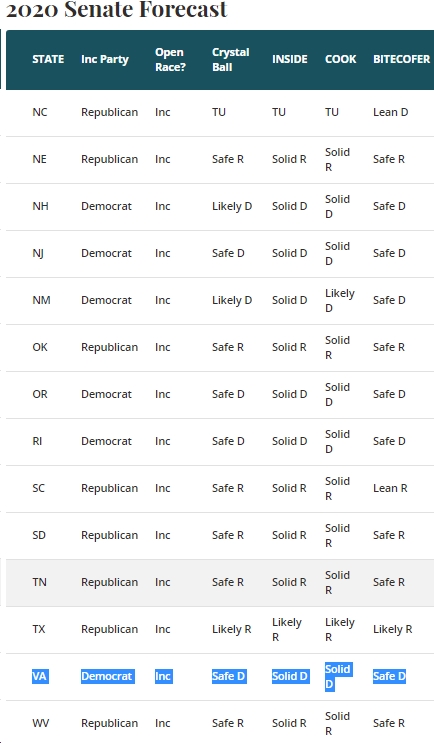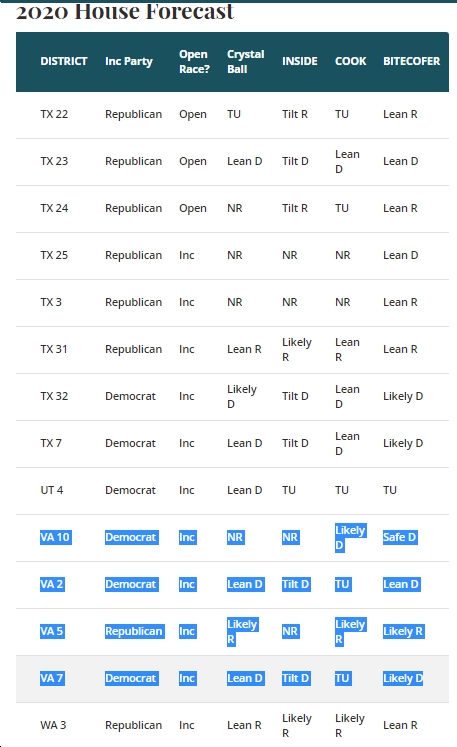This morning, former CNU Professor, Niskanen Center Senior Fellow and elections analyst/modeler Rachel Bitecofer is out with her forecasts for this November’s elections – “Negative Partisanship and the 2020 Congressional Elections” – and it’s well worth a read. See below for a few general, and Virginia-related, takeaways (bolding added by me for emphasis), as well as predictions for the U.S. Senate race in Virginia (“Safe D” for Mark Warner); and key, competitive U.S. House races in Virginia (“Safe D” for Rep. Jennifer Wexton in VA-10, “Likely D” for Rep. Abigail Spanberger in VA-07, “Lean D” for Rep. Elaine Luria in VA-02 and “Likely R” for Rep. Denver Riggleman in VA-05). Overall, Bitecofer expects Democrats not just to hold the U.S. House, but to add to their majority. As for the Senate, Bitecofer writes, “Democrats are in superior positions in three of the four swing races they need to win a 50-vote majority and have five prospects from which to glean their fourth seat. That makes for a lot of points of weakness for Republicans to defend in an environment that grows more politically hostile by the day.”
With that, check out Professor Bitecofer’s entire analysis, which is top-notch (I agree with pretty much all of it, although I’d probably make VA-02 “Likely D” and VA-07 “Lean D”), as well as the following “takeaways” that jumped out at me. What jumped out at you?
P.S. For more thoughts on Professor Bitecofer and her analytical efforts, see CNU Professor Rachel Bitecofer Is Really Having a Moment. And That’s a Very Good Thing.
- “Ultimately, what determines electoral victories in the partisan era is the partisan composition of the electorate: the percentage of the electorate that is composed of Democrats and left-leaning independents versus the percentage that is composed of Republicans and right-leaning independents. And in 2020, in places where partisan competition is equalized (places like Wisconsin), it will be the coalition that is angrier and/or more frightened that wins that battle, even when voting infrastructure is manipulated to discourage participation.”
- “Everywhere and anywhere competitive elections run up against Republican control of some or all of a state’s government, it’s probably reasonable to expect some degree of election-administration strategic skullduggery…Generally, in states where voting is made easy, more people vote, and in states where it is made difficult, fewer people vote…at the end of the day (and as Wisconsin shows) suppression can only take you so far in the face of a riled-up opposition.”
- “When the negative partisanship model meets a contest with demographics ready to produce a large turnout surge, and voting is easy, the probability for a Democratic victory is enhanced.”
- “As I discussed in my presidential forecast, prior to the COVID-19 pandemic, I was anticipating something approaching — perhaps even reaching — 70 percent turnout in the 2020 general election, which is about 10 points higher than the 2016 turnout and would be history-making.”
- “…the blue wave that washed through America’s suburbs in 2018 was powered by a massive turnout of Democrats and independents, who showed up in droves to toss Republican House incumbents out of office and send a message to Donald Trump.”
- “Whatever 2020 turnout is, barring something extraordinary that disrupts the election, if more Democrats and left-leaning independents vote than did so in 2016 and pure independents break against Trump and congressional Republicans, Democrats will not only hold their 2018 House gains — they are poised to expand on their House majority and are competitive to take control of the Senate.“
- “…voters are likely to forgive Trump the [COVID-19] crisis itself, but they will judge him on how he, and by extension, his party, handles the response, a record that is already plagued with allegations of mismanagement…We’ve already witnessed something unprecedented in terms of the public’s reaction to the crisis: a near-total lack of what is known as the “rally around the flag effect,” which refers to the public’s tendency to rally around their leader during national crises…Trump will not have a goodwill reservoir to draw from as the extent of the crisis begins to materialize — a scary prospect for his reelection team. “
- “…polarization will likely provide Trump a robust cushion regardless of how severe the crisis gets, a solid floor that presidents from other eras could not have enjoyed.”
- ” For a good number of the 2018 Democratic House freshmen, their 2020 reelections will likely play out similarly to those of the 2017 freshman Democrats in the Virginia House of Delegates, who stood for their first reelections in 2019 and overperformed (well, at least other people’s expectations) by winning decisively. This even includes a victory by Lee Carter, a self-described democratic socialist who ousted a five-term Republican incumbent in 2017 and, despite robust attacks from the state’s Republican Party over his ideological extremism and an endorsement by Bernie Sanders, won his 2019 reelection bid by seven points.”
- “Unless the pandemic has a massive disruptive effect on the election itself, my expectation is the 2020 congressional cycle will closely resemble Virginia’s 2019 cycle. After the 2017 blue wave in Virginia, seats were left on the table because Democrats didn’t appreciate just how deep their newfound advantages ran in America’s suburbs. As in Virginia’s 2019 cycle, Democrats benefit from Republican strategic retirements that all but hand them a couple of easy pick-ups. As in 2019 Virginia, Democrats will also benefit from a couple ‘gimme’ seats from a court-ordered redistricting, picking up two in North Carolina (NC-2 and NC-6) after federal courts ruled the state’s map unconstitutional due to racial gerrymandering. And just as in Virginia in 2019, the Republicans are exposing a couple of very vulnerable swing Senate seats for the first time to the post-Trump electorate, putting a narrow majority in the upper chamber in contention. In Virginia, Democrats barely eked out a trifecta after underperforming in two key state Senate races. What happens in the United States Senate will come down to how much Democrats learned from those underperformances (or not) and have improved their electioneering strategies since the 2018 and 2019 cycles.”
- “…polling data shows education level is a statistically significant predictor of Trump support. This is common knowledge now, but in the run-up to Virginia’s 2017 election, when I was first arguing my theory, and even in 2018, the first time I used college education to predict where Democrats would gain big in the midterms, the idea that the 2018 wave was an education wave was fairly novel. While I was building my 2018 model, I retroactively modeled Virginia’s 2017 state legislative elections and saw that a district’s rate of college education was a good indicator of control flip. I realized I’d uncovered a powerful, new bellwether for predicting Democratic electoral strength”
- “If you’re reading this, you only have one burning question — can Democrats flip the Senate? So, I’ll cut to the chase: They have a good chance of it…Democrats appear to need just 3 seats to win control, but as many of you already know, because one of their current seats is up for reelection in deep red Alabama, Democrats likely need to pick up four seats this cycle to offset that potential loss…My forecast suggests three of these seats are likely flipping to Democratic control.“
- “[Democrats’] success in Maine (and elsewhere) will be contingent on how closely they marry Collins to Trump…Both Arizona and Colorado are much easier ground than Maine is, because both states offer racial diversity, while Maine is 94 percent white. Speaking of Colorado, if Virginia had a realignment cousin it would be the state of Colorado, and that is very bad news for the state’s incumbent Republican senator, Cory Gardner. I consider Cory Gardner to be the Barbara Comstock of the 2020 cycle — that is to say, he has the unfortunate distinction of being the most endangered Republican incumbent in the country (out of both chambers).”
- “… it will take a new, unprecedented deviation to hand [Doug] Jones a second, full term. Not impossible due to the introduction of the pandemic and potentially, depression-level economic damages, mind you. But not likely. “
- “Democrats need at least one more seat to secure 50. And they have five viable options. By far the most attractive of these is the North Carolina Senate seat currently held by Thom Tillis. Democrats are perfectly capable of winning North Carolina in 2020.”
- “Cunningham’s fortunes in NC, as well as those of many of the Democratic candidates in the down-ticket state legislative races, will hang on the turnout rates of black voters, so if Democrats are serious about winning there, they should be working feverishly to adopt Stacey Abrams’ “playbook” from her failed-but-close 2018 bid for Georgia governor because that effort, in North Carolina, would be a game-changer. Indeed, failure to understand this, and adapt their strategies to account for it, cost Virginia Democrats those two additional state Senate seats and likely, a couple additional seats in the state’s House of Delegates. Although fortunately, for them, they had room for error as they sought control of the General Assembly.”
- “Of course, the Cunningham campaign might get a major assist from the Biden campaign if the Biden campaign selects a running mate of color and/or one that galvanizes younger voters. We already know Biden’s running mate will be a woman, but a female woman of color, say, Kamala Harris, Stacey Abrams, or Val Demmings, would be a game-changer for this Senate race…It would also be a game-changer in the Democrats’ effort to flip one, or perhaps both, of Georgia’s Senate seats. “
- “If Democrats win the White House and flip the Senate in 2020, it will be because many more young voters and voters of color turn out in 2020 than did in 2016, as was the case in 2018. This surge will be predominantly generated by college-educated voters, and not only white ones because the demographics of America’s suburbs today are profoundly different than they were 30 years ago. Thus, if one endeavors to elect Democrats at any level of office, voter participation and turnout must be the focal point of the campaign’s effort.”
- “In terms of overall forecast, Democrats have at least a dozen very attractive prospects in the House to add to their already robust House majority and they should be able to win some of these seats under any electoral strategy. But one that focuses resources on Democratic coalition voter turnout and exploits the referendum effect has potential to increase those prospects significantly.”
- “In terms of the Senate, Democrats are in superior positions in three of the four swing races they need to win a 50-vote majority and have five prospects from which to glean their fourth seat. That makes for a lot of points of weakness for Republicans to defend in an environment that grows more politically hostile by the day.”















